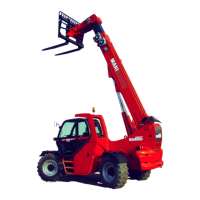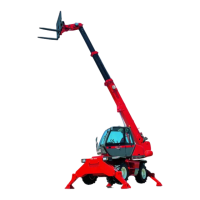14
1
MHT 10120 L M
SS
eries
C - Taking up a high load.
A load MUST NOT be picked up unless the lift truck is on a level surface (See para-
graph: G - LIFT TRUCK HORIZONTALITY in the Chapter: HANDLING A LOAD).
- Ensure that the forks will easily pass under the load.
- Position the lift truck perpendicular to the load with the forks in a horizontal position
(Fig. G) manoeuvring gently and carefully (See paragraph : E - VISIBILITY in the chap-
ter : HANDLING INSTRUCTIONS for visibility of the road).
Always think about keeping the distance necessary to fit the forks under the load,
between the pile and the lift truck (Fig. G) and use the shortest possible length of jib.
- Stop with the forks in front of the load (Fig. H). Action the parking brake and place the
forward/reverse lever in neutral.
- Slightly lift the load (1) and incline the forks carriage (2) backwards to stabilize the load
(Fig. I).
Tilt the load sufficiently backwards to ensure its stability (loss of load on braking) without
upsetting the balance of the load in so doing.
- If possible (Fig. J), lower the load without shifting the lift truck. Lift the jib (1) to release
the load, retract (2) and lower the jib (3) to bring the load into the transport position
(Fig. J).
- If this is not possible, back the lift truck up (Fig. K). Manoeuvring very gently and care-
fully (See paragraph : E - VISIBILITY in the chapter : HANDLING INSTRUCTIONS for
visibility of the road), back up the lift truck (1) to release the load, retract (2) and lower
the jib (3) to bring the load into the transport position (Fig. K).
G
H
I
J
K

